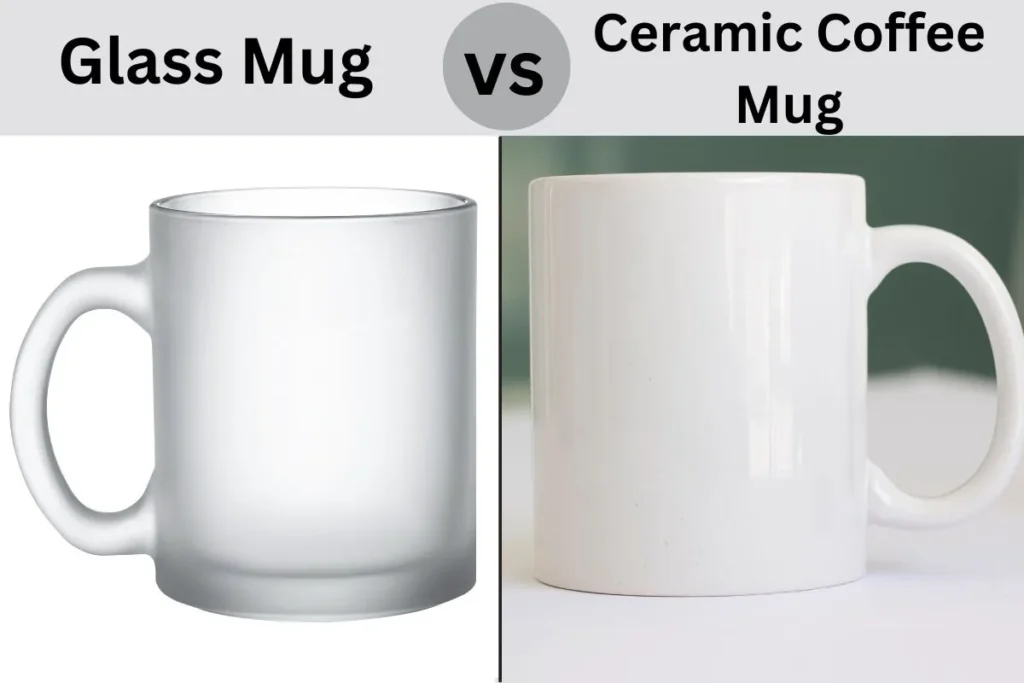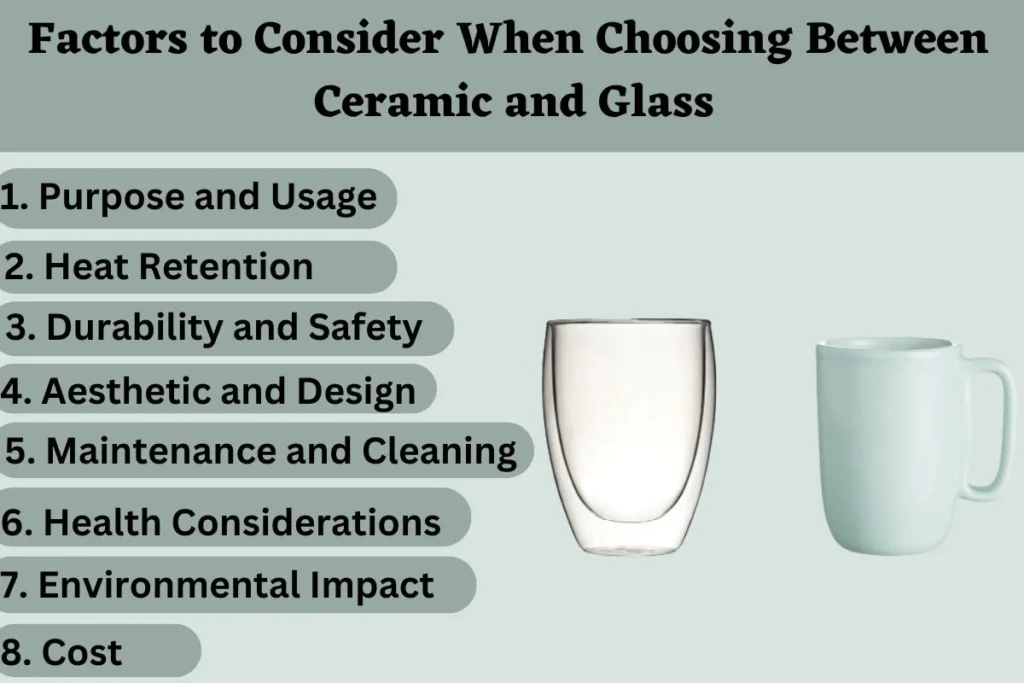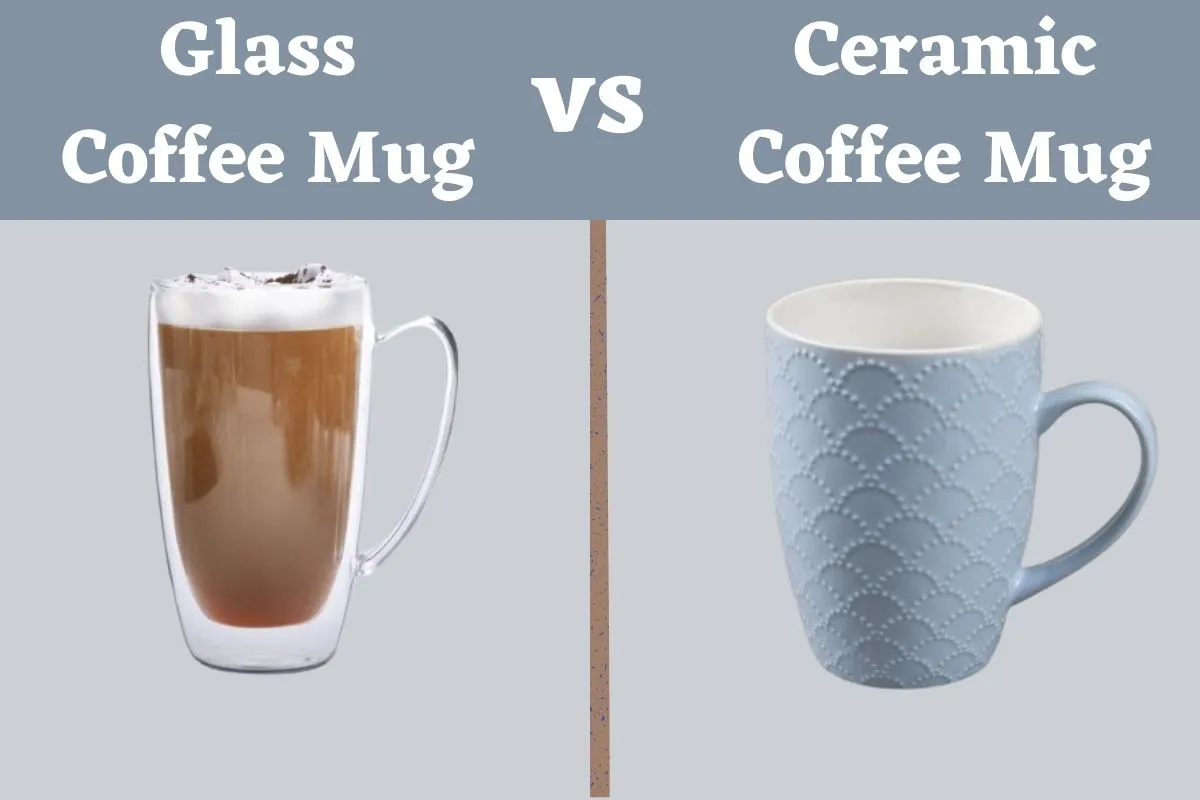When it comes to savoring a perfect cup of coffee, the vessel you choose can be just as important as the brew itself. Coffee enthusiasts often find themselves contemplating the age-old question: glass or ceramic mug?
While both materials have their merits, the decision ultimately depends on your personal preferences and priorities. In this article, we’ll dive deep into the world of coffee mugs, exploring the unique characteristics of glass and ceramic options.
Whether you’re a casual sipper or a passionate aficionado, understanding the nuances of glass and ceramic mugs will elevate your enjoyment and help you create cherished moments with every brew.
A Brief History of Glass vs Ceramic Coffee Mug
Ceramic and glass mugs, each with their unique histories, have been central to the cultural rituals of drinking beverages across the world.
Ceramic Mugs
Ceramics have been used for thousands of years, with some of the earliest known pottery dating back to 24,000 BC in China. The use of ceramic vessels for drinking emerged not long after. These early ceramics weren’t the mugs we know today but were more akin to bowls and wide-mouthed vessels.
The innovation of the mug, particularly with a handle, is a much later development. It is believed that ceramic mugs were first created in the Neolithic period, as pottery techniques evolved to include handles for easier use.
By the time of the Middle Ages in Europe, ceramic mugs were quite common for drinking ales and other beverages. The material’s insulating properties, combined with its ability to be easily shaped and decorated, made it ideal for use in households and public houses alike.
Glass Mugs
Glass, although used in ancient times, became a common material for drinking vessels only in the Roman Empire, around the 1st century BC. However, glass mugs as we might recognize them did not become widespread until the advent of glassblowing, which allowed for more varied and complex shapes.
The industrial revolution and the development of automated glass-making machines in the 19th century drastically reduced the cost and increased the availability of glassware to the general public.
This democratization of glass production made glass mugs more commonplace. The clarity of glass was particularly prized for showing off the color and quality of beverages, making glass mugs popular for drinks like tea, where the color of the brew was an important quality indicator.
Advantages of Ceramic and Glass Mugs
Ceramic and glass mugs, popular choices for serving beverages, each offer distinct advantages that cater to different preferences and uses:
Advantages of Ceramic Mugs
- Heat Retention: Ceramic mugs are excellent at retaining heat due to their thicker walls. This property keeps beverages warm for a longer period, making them ideal for coffee, tea, or hot chocolate.
- Durability: High-quality ceramic mugs are durable and resistant to wear and tear. They can withstand daily use and frequent washing without losing their finish or color.
- Microwave Safe: Most ceramic mugs can be used in the microwave, making it easy to reheat beverages directly in the mug without the need for a separate container.
- Customization: Ceramics can be easily molded and painted, which allows for a wide range of designs, colors, and textures. This makes ceramic mugs popular for personalized or promotional items.
- Non-reactive Surface: The glazed surface of ceramic mugs does not react with the beverage, ensuring that the flavor and aroma of your drink are not altered.
Advantages of Glass Mugs
- Aesthetic Appeal: Glass mugs offer a clear view of the beverage, making them ideal for serving layered or color-rich drinks like specialty coffees or teas. This can enhance the sensory enjoyment of the drink.
- Chemical Stability: Glass does not absorb odors or flavors, and it does not leach chemicals into the drink. This makes it a healthier choice for enjoying the pure taste of the beverage.
- Hygiene: Glass surfaces are non-porous and easy to clean, preventing the buildup of bacteria and other contaminants. Glass mugs can be sterilized completely, which is why they are often used in restaurants and cafes.
- Durability in Temperature: Glass mugs made from tempered or borosilicate glass can withstand sudden changes in temperature, from very hot to very cold, without shattering. This makes them versatile for a range of hot and cold beverages.
- Environmentally Friendly: Glass is 100% recyclable, and it can be recycled continuously without loss of quality or purity. This makes glass mugs a more sustainable option for eco-conscious consumers.
Disadvantages of Ceramic and Glass Mugs
Ceramic and glass mugs are popular for their unique benefits, but they also come with some disadvantages that might affect their suitability for certain uses:
Disadvantages of Ceramic Mugs
- Weight: Ceramic mugs are generally heavier than their glass or plastic counterparts. This can make them less comfortable for some users, especially when used for larger drinks.
- Fragility: While ceramic is durable, it is also brittle. A ceramic mug can easily crack or shatter if dropped, making it less ideal for use in environments where rough handling is likely.
- Poor Thermal Conductivity: Ceramic mugs, though excellent at retaining heat, can sometimes hold heat too well, making the exterior hot to the touch and potentially leading to burns if not handled carefully.
- Inconsistency in Manufacturing: The process of making ceramic mugs can result in inconsistencies such as slight variations in shape, size, and color, especially if they are handcrafted. This might be undesirable in settings where uniformity is important.
- Staining: The porous nature of ceramic, especially if not properly glazed, can lead to staining from tea, coffee, or other beverages, which might affect the mug’s appearance over time.
Disadvantages of Glass Mugs
- Heat Retention: Glass mugs, particularly those that are not double-walled, are not as good at retaining heat as ceramic mugs. Beverages can cool down more quickly, which may be a disadvantage for drinks intended to be served hot.
- Fragility: Glass is also brittle and can easily break or shatter upon impact. This makes glass mugs a risky choice in households with children, pets, or in outdoor settings.
- Heat Transfer: Traditional glass mugs can become very hot when filled with a hot liquid, making them difficult to handle without a protective sleeve or handle.
- Weight and Thickness: High-quality glass mugs that are durable enough to handle thermal stress tend to be thicker and heavier, which might not be as comfortable to hold for some users.
- Cost: Depending on the type of glass used (like borosilicate), glass mugs can be more expensive than ceramic or plastic alternatives.
Glass vs Ceramic Coffee Mug Comparison

| Characteristics | Glass Coffee Mugs | Ceramic Coffee Mugs |
| Transparency and Aesthetics | Clear, allowing for appreciation of coffee’s color and texture | Opaque, available in various colors,designs, and patterns |
| Heat Retention | Moderate heat retention | Excellent heat retention, keeps coffee warmer for longer |
| Fragility | More fragile, prone to breakage if mishandled | Sturdier and less prone to chipping or breaking |
| Versatility | Suitable for hot and cold beverages | Versatile, suitable for various beverages and serving styles |
| Durability | Less durable compared to ceramic | Highly durable, withstands everyday use and occasional knocks |
| Aesthetics and Customization | Limited customization options due to transparency | Wide range of designs and customization possibilities |
| Cleaning and Maintenance | Generally easy to clean, but may require careful handling | Easy to clean, often dishwasher and microwave safe |
Factors to Consider When Choosing Between Ceramic and Glass

When deciding between ceramic and glass mugs, several factors should be considered to ensure you choose the best option for your specific needs and preferences. Here are some key considerations:
1. Purpose and Usage
- Ceramic: Ideal for keeping beverages hot for longer periods due to better insulation. Perfect for home or office environments where drinks might sit for extended periods.
- Glass: Best for serving beverages where the visual appeal of the drink is important, such as teas or specialty coffees. Suitable for settings where aesthetics are a priority, like in cafés or during formal gatherings.
2. Heat Retention
- Ceramic: Offers excellent heat retention, making it suitable for slow drinkers or for enjoying hot beverages during cold weather.
- Glass: Typically less effective at retaining heat unless it’s double-walled. Double-walled glass mugs are better at insulating but might be more expensive.
3. Durability and Safety
- Ceramic: Generally robust but prone to chipping or breaking if dropped. Not ideal for use around children or in outdoor activities.
- Glass: Fragile and can easily break when mishandled, posing a risk for cuts. However, tempered glass options are available which offer enhanced durability and safety.
4. Aesthetic and Design
- Ceramic: Available in a wide range of colors, designs, and finishes. Ceramic can be customized with logos or images, making it a popular choice for promotional items or personalized gifts.
- Glass: Provides a clean and modern look, allowing the color and texture of the beverage to be seen, enhancing the sensory experience of drinking.
5. Maintenance and Cleaning
- Ceramic: Easy to clean and generally dishwasher safe. Some ceramic mugs may stain over time, especially if not glazed properly.
- Glass: Also easy to clean and typically dishwasher safe. Glass does not retain odors or stains, maintaining its clarity over time.
6. Health Considerations
- Ceramic: Usually safe, but low-quality glazes can sometimes contain harmful materials like lead or cadmium. It’s important to ensure that ceramic mugs are made with food-grade, safe materials.
- Glass: Chemically inert, making it one of the safest choices for drinkware. It does not leach chemicals into beverages, maintaining the purity of the drink’s taste.
7. Environmental Impact
- Ceramic: Although durable, the production of ceramic can be resource-intensive. However, it’s reusable and can be more environmentally friendly than disposable options.
- Glass: Highly recyclable and can be made from recycled materials, reducing its environmental footprint.
8. Cost
- Ceramic: Prices can vary widely based on the quality of the material and the complexity of the designs.
- Glass: Basic glass mugs may be affordable, but high-quality or specialty glass like borosilicate can be more expensive.
Impact of Mug Material on Coffee Flavor
The material of the mug from which you drink can subtly impact the flavor and overall experience of enjoying coffee. While the differences might not be as pronounced as the effects of coffee variety or brewing method, they are certainly perceptible to keen coffee enthusiasts. Here’s how ceramic and glass mugs can influence the coffee experience:
Ceramic Mugs
Heat Retention:
Ceramic mugs are excellent at retaining heat due to their thicker and more insulating material properties. This prolonged heat retention can affect the flavor of the coffee by keeping it warmer for longer, which is ideal for drinks that are savored slowly. Warmer coffee tends to release more aroma, enhancing the sensory experience.
Impact on Flavor:
Ceramic is a porous material, although it’s usually glazed. A high-quality glaze on a ceramic mug should prevent any absorption of flavors; however, poor-quality ceramic might absorb old flavors and odors, which can subtly influence the taste of fresh coffee over time.
Sensory Experience:
The thicker walls of ceramic mugs also affect the temperature at which the coffee hits your lips. This can slightly change your perception of its temperature and taste, as some flavors are more pronounced at different temperatures.
Glass Mugs
Flavor Purity:
Glass is non-reactive and does not impart any additional flavors or odors to coffee, ensuring that the flavor remains pure and unchanged. This makes glass an excellent choice for tasting high-quality, single-origin coffees where clarity and subtlety of flavor are paramount.
Heat Transfer:
Glass mugs, unless double-walled, generally do not retain heat as well as ceramic mugs. This faster cooling rate can affect the flavor profile of the coffee, potentially making it less aromatic as it cools. However, for some iced coffee drinks, this can be an advantage as it allows the coffee to reach a palatable cold temperature quickly.
Aesthetic Influence:
The clarity of glass mugs provides a visual enjoyment of the coffee, allowing you to see the color and texture of the brew. This visual aspect can enhance the perceived freshness and quality of the coffee, indirectly influencing its taste through sensory integration.
Caring for Glass and Ceramic Mugs
Proper care and maintenance of your glass and ceramic mugs can significantly extend their lifespan and keep them looking as good as new. Here are some tips on how to care for each type:
Caring for Ceramic Mugs
- Regular Cleaning: Wash ceramic mugs after each use with warm water and a mild detergent. Hand washing is recommended, although most ceramic mugs are dishwasher safe. If using a dishwasher, place them securely on the top rack to avoid chips and cracks.
- Avoid Abrasive Scrubbers: Use a soft cloth or sponge for cleaning. Avoid using abrasive scrubbers like steel wool, as they can scratch the surface and damage the glaze.
- Handling Chips and Cracks: Check regularly for any chips or cracks. If a mug is chipped or cracked, it can harbor bacteria and may also leak, so it’s best to retire it from use for hot beverages.
- Preventing Stains: To remove coffee or tea stains, fill the mug with a mixture of warm water and baking soda or vinegar and let it soak for a few hours before scrubbing gently. Alternatively, denture cleaning tablets can be used for soaking to remove stubborn stains.
- Thermal Shock: Avoid exposing ceramic mugs to sudden temperature changes, such as pouring boiling water into a cold mug. Pre-warming the mug with warm water can minimize the risk of thermal shock, which can cause cracking.
Caring for Glass Mugs
- Cleaning: Glass mugs can generally be washed in the dishwasher, but hand washing is recommended to maintain their shine and prevent cloudiness over time. Use mild detergent and a soft sponge or cloth.
- Avoiding Breakage: Handle glass mugs with care, as they can easily break if dropped or knocked against hard surfaces. Store them in a location where they won’t be easily knocked over.
- Removing Cloudiness: Over time, glass can develop a cloudy appearance due to hard water deposits. To clear this, soak the mugs in white vinegar for a few hours and then wash as usual.
- Using Appropriate Tools: Use non-abrasive tools to clean glass mugs. Abrasive brushes or scrubbers can leave scratches that make the glass look dull.
- Heat Exposure: While glass mugs designed for hot beverages are generally safe to use in microwaves, it’s crucial to avoid rapid temperature changes. Ensure that the glass is rated for use with hot liquids, and avoid using glass mugs that have metallic paints or decals in the microwave.
- Checking for Damage: Regularly inspect glass mugs for any small cracks or chips. Even minor damage can lead to breakage when the mug is filled with a hot beverage.
Best Glass and Ceramic Mug Styles for Various Coffee Drinks
Selecting the right mug style for different coffee drinks can enhance both the visual appeal and the tasting experience. Here’s a guide to choosing specific glass and ceramic mug styles for various coffee drinks:
1. Espresso
- Glass: A small, clear demitasse cup is ideal for espresso. It allows the drinker to appreciate the rich color and the crema layer on top. A double-walled glass demitasse can also help insulate the drink and maintain its temperature without burning fingers.
- Ceramic: A traditional thick-walled ceramic demitasse cup helps retain heat, keeping the espresso warm. These are typically about 2-3 ounces in size.
2. Americano
- Glass: A clear, tall glass showcases the layering of espresso and water, enhancing the simplicity and elegance of an Americano.
- Ceramic: A standard ceramic coffee mug (about 8-12 ounces) is perfect, as it retains the heat and offers a classic coffee drinking experience.
3. Latte
- Glass: A tall, wide-mouthed glass mug is excellent for lattes, particularly if they include latte art. The clear glass showcases the layers of coffee and milk, as well as the art on top.
- Ceramic: A wide-mouthed ceramic bowl or mug, typically 12-16 ounces, provides ample surface area for latte art and helps maintain the temperature of the drink.
4. Cappuccino
- Glass: A medium-sized, 6-ounce glass cup can work well for cappuccinos, allowing the layers of espresso, steamed milk, and frothy milk to be displayed attractively.
- Ceramic: A traditional 6-ounce cappuccino cup with a saucer is ideal. The thick walls help maintain the temperature, and the wide top supports a good ratio of foam.
5. Mocha
- Glass: A tall, slender glass shows off the layering of chocolate, espresso, and milk, making it a visually appealing choice for a mocha.
- Ceramic: A larger, 12-ounce ceramic mug accommodates the added volume from chocolate syrups or melted chocolate, along with the espresso and milk.
6. Flat White
- Glass: A smaller, 5 to 6-ounce tulip-shaped glass cup can be perfect for flat whites, as it helps maintain a velvety texture by keeping the milk and espresso well integrated.
- Ceramic: A tulip-shaped ceramic cup of similar size to the glass option also works well, ensuring heat retention and optimal milk to coffee ratio.
7. Iced Coffee Drinks
- Glass: Large, sturdy glass mugs or mason jars are excellent for iced coffee drinks. The transparency of the glass enhances the visual appeal of the drink, showing the ice, coffee, and any added layers like syrups or creams.
- Ceramic: Generally, ceramic is not used for iced drinks due to its heat-retaining properties, which aren’t necessary for cold beverages.
Conclusion
In the eternal debate of glass vs ceramic coffee mugs, there is no clear winner. Each kind accommodates various tastes and lifestyles and has special qualities and benefits of its own. Whether you prioritize aesthetics, durability, or insulation, there’s a coffee mug out there that’s perfect for you. Thus, go slowly, consider your alternatives, and select the brew companion that best fits your preferences and requirements.
Frequently Asked Questions
Q1. Can I microwave both glass and ceramic coffee mugs?
Indeed, mugs made of glass or ceramic can be placed in the microwave without risk; nonetheless, it’s advisable to confirm with the manufacturer.
Q2. Do stains occur more frequently in glass mugs?
Glass mugs may develop stains over time, especially if used for dark-colored beverages, but they can usually be easily cleaned with proper care.
Q3. Do ceramic mugs retain flavors?
Ceramic mugs can sometimes retain flavors, particularly if they are porous or have cracks in the glaze. Regular cleaning can help prevent this.
Q4. Which type of mug is better for traveling?
Because they are less prone to crack or chip while in transportation, ceramic mugs are typically more robust and ideal for travel.
Q5. Can I customize my own glass or ceramic mug?
Yes, many companies offer customization services for both glass and ceramic mugs, allowing you to add personalized designs or messages.

Rossi Glover, the passionate Owner of Grand Lake Coffee, infuses every cup with her love for coffee and dedication to quality. With an extensive background in the art and science of coffee, Rossi is not just a connoisseur but a storyteller, sharing the intricate tales behind each brew.

